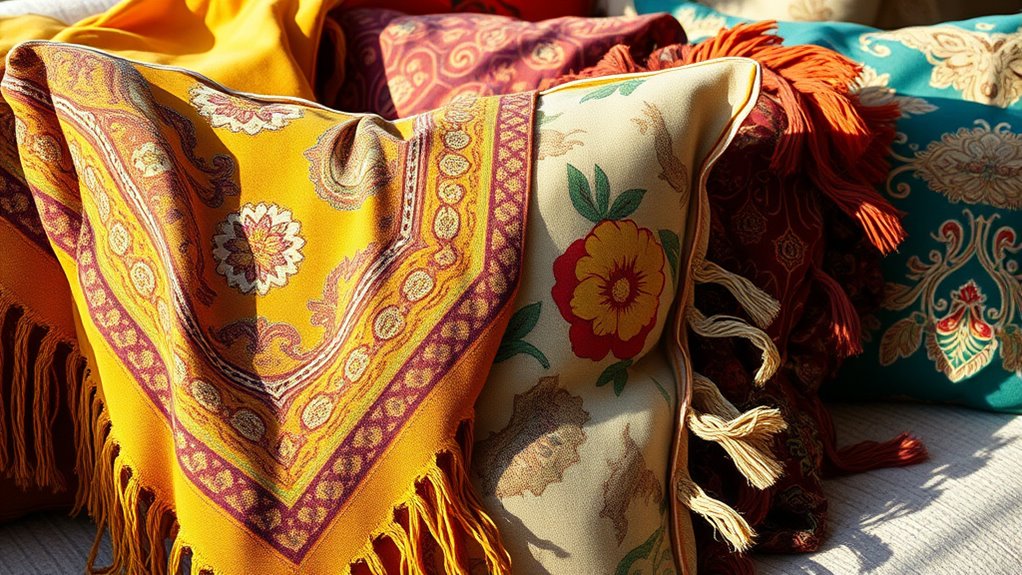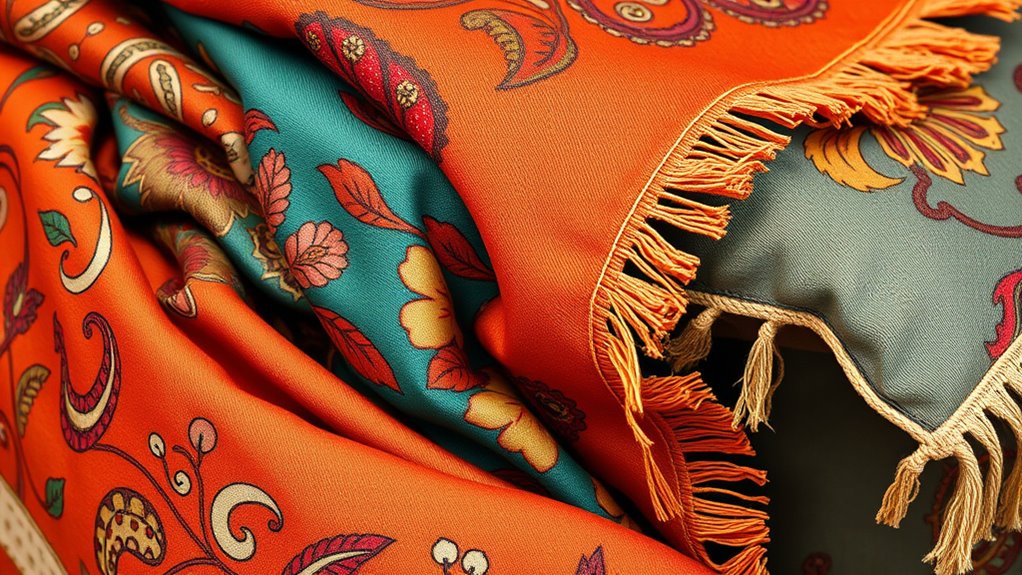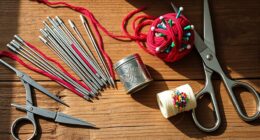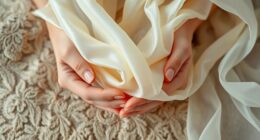To turn old scarves into boho pillow covers, start by choosing lightweight fabrics with vibrant patterns or earthy tones that match your style. Measure your pillow inserts and cut or fold the scarves accordingly, then sew or glue the edges for a seamless look. Add embellishments like fringe, tassels, or embroidery for extra flair. This eco-friendly project is quick and customizable—keep going to discover more tips on creating unique, stylish pillow covers with your scarves.
Key Takeaways
- Choose lightweight, vibrant fabrics like silk or chiffon for a boho aesthetic and measure pillow inserts accurately before cutting.
- Use the scarf’s finished edges or decorative features to simplify sewing or gluing pillow covers.
- Sew or glue scarf edges around the pillow, leaving one side open for easy insertion and removal.
- Add embellishments like tassels, fringe, or embroidery to enhance the boho style and personalize the pillows.
- Repurposing scarves into pillow covers promotes sustainability and creates colorful, eclectic home decor.

Transforming old scarves into boho pillow covers is a creative way to refresh your home decor while giving new life to items you no longer wear. This project allows you to practice upcycling techniques that breathe new character into your space without spending a fortune. The first step involves fabric selection, which is vital for achieving the boho aesthetic you desire. Opt for scarves made from lightweight, flowy fabrics like silk, chiffon, or lightweight cotton, as these materials lend a relaxed, bohemian vibe. Bright patterns, vibrant colors, and eclectic prints work beautifully for this style, but solid, muted tones can also create a more subdued, earthy look. Choose scarves that resonate with your personal taste and match your existing decor.
Once you’ve selected your fabric, you should consider the upcycling techniques you’ll use. Since scarves are often already finished with hems or decorative edges, you can leverage these features to simplify the project. For instance, if your scarf has a finished edge, you can fold it over a pillow and sew along the edges, creating a seamless cover. If the scarf is large enough, you might use it as a wrap-around cover, sewing or gluing the edges to fit your pillow size. For smaller scarves or those with frayed edges, a simple hem or decorative stitch can secure the edges and prevent fraying. You can also add embellishments like tassels, embroidery, or fringe to enhance the boho feel.
Leverage finished edges and embellishments to easily create stylish boho pillow covers from scarves.
When working with fabric, it’s important to measure your pillow insert carefully—adding a little extra to the dimensions will guarantee a snug fit. You can cut the scarf to size, keeping in mind the fabric’s pattern and directionality. Use a straight stitch or a zigzag stitch to sew the pillow cover together, especially if you want to prevent fraying. Leaving one side open allows you to insert or remove the pillow easily. If sewing isn’t your forte, fabric glue or iron-on adhesive can be effective alternatives, particularly for decorative accents or hems. Additionally, understanding the importance of fabric durability can help ensure your pillow covers last over time.
Finally, consider finishing touches that emphasize the boho aesthetic—fringe, pom-poms, or beaded accents can be sewn onto the edges for added flair. With a little creativity and some basic sewing skills, transforming old scarves into boho pillow covers becomes a fun, sustainable project. Not only do you get to personalize your decor, but you also contribute to reducing waste by repurposing items you already own. This approach makes your home feel more vibrant, eclectic, and uniquely yours—all while practicing eco-friendly upcycling techniques.
Frequently Asked Questions
What Types of Scarves Work Best for DIY Pillow Covers?
When choosing scarves for DIY pillow covers, opt for fabrics with interesting textures like silk, chiffon, or cotton for a cozy feel. Bright, bold colors or patterns work well for a boho look, but make sure the colors coordinate with your existing decor. Avoid very delicate fabrics that may tear easily. Ultimately, select scarves that balance texture and color, creating a vibrant, cohesive appearance for your pillow covers.
Can I Use Synthetic Scarves for This Project?
Yes, you can use synthetic scarves for this project, but keep in mind that fabric dyes may not work as well on synthetic fibers. You might need to use specific dyes designed for synthetics. Also, be aware that sewing techniques could differ slightly, as synthetic fabrics can be more slippery. Test your fabric first and adjust your sewing approach accordingly to make sure your boho pillow covers turn out beautifully.
How Do I Clean or Wash the Finished Pillow Covers?
Ever wonder how to keep your boho pillow covers fresh and vibrant? To clean them, gently hand wash or use a delicate cycle in your washing machine. Use mild detergent, apply fabric softening if desired, and focus on stain removal before washing. Avoid harsh chemicals to preserve the fabric’s charm. Air dry or tumble dry on low heat to maintain their beauty, ensuring your creative project stays lovely for years.
Are There Eco-Friendly or Sustainable Options for Scarf Recycling?
You’re wondering if eco-friendly or sustainable options exist for scarf recycling. You can explore recycling methods that focus on repurposing scarves into new items, like pillow covers or bags, using sustainable materials. Look for programs or local initiatives that accept textiles for recycling, or try DIY projects that give old scarves a second life. This way, you reduce waste and support environmentally friendly practices, making your recycling efforts more impactful.
How Long Does the Entire Transformation Process Typically Take?
Think of transforming scarves into pillow covers as a cozy baking session—timing varies. It usually takes about 1-2 hours, depending on your sewing skills. Since scarf durability and color fading concerns matter, factor in extra time for gentle handling and proper sealing. The process can be quick if you’re experienced or a little longer if you need to be cautious, ensuring the final product lasts and keeps its vibrant charm.
Conclusion
So, next time you’re about to toss that old scarf, think twice. Instead of clutter, you could be creating a chic boho pillow cover, turning your wardrobe’s leftovers into stylish decor. Who knew that those forgotten scarves could become the centerpiece of your living room? It’s funny how something so simple, like repurposing fabric, can give your space a fresh vibe—proving that sometimes, the best ideas are hiding right in your closet.









